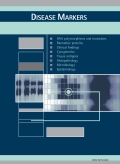Authors: Kim, Hyun Soo | Choi, Dongseok | Lim, Lyndell L. | Allada, Gopal | Smith, Justine R. | Austin, Carrie R. | Doyle, Trudy M. | Goodwin, Kelley A. | Rosenbaum, James T. | Martin, Tammy M.
Article Type:
Research Article
Abstract:
Interleukin 23 receptor (IL23R) gene has been reported as a genetic factor strongly associated with inflammatory bowel disease, psoriasis, and ankylosing spondylitis. We investigated the association between IL23R gene single nucleotide polymorphisms (SNPs) and susceptibility to sarcoidosis, including the clinical manifestation of uveitis. Ninety-one sarcoidosis subjects (58 with and 33 without uveitis) and 104 healthy controls were genotyped for eleven IL23R SNPs. DNA was amplified using specific PCR primers and
…genotyped by denaturing HPLC and/or direct DNA sequencing. Case-control frequency comparisons were analyzed using Chi square test. Three IL23R SNPs, rs7517847 (intron 6), rs11465804 (intron 8), and rs11209026 (exon 9, c.1142G>A, p.Arg381Gln) were associated with sarcoidosis in our population (p<0.05): rs7517847 showed increased frequencies in sarcoidosis compared to controls, but rs11465804 and rs11209026 were decreased. Two of these SNPs were associated with the uveitis subgroup compared to controls: rs11465804 (0.9% vs. 7.2%, OR=0.11, P=0.013) and rs11209026 (1.8% vs. 7.3%, OR=0.23, P=0.038). This finding indicates the association of IL23R polymorphism with sarcoidosis, especially with sarcoid uveitis. IL23R may be a common susceptibility gene shared by several autoimmune disorders including inflammatory bowel disease, psoriasis, and ankylosing spondylitis and sarcoid uveitis.
Show more
Keywords: Interleukin 23 receptor, polymorphism, sarcoidosis, uveitis
DOI: 10.3233/DMA-2011-0796
Citation: Disease Markers,
vol. 31, no. 1, pp. 17-24, 2011
Price: EUR 27.50





